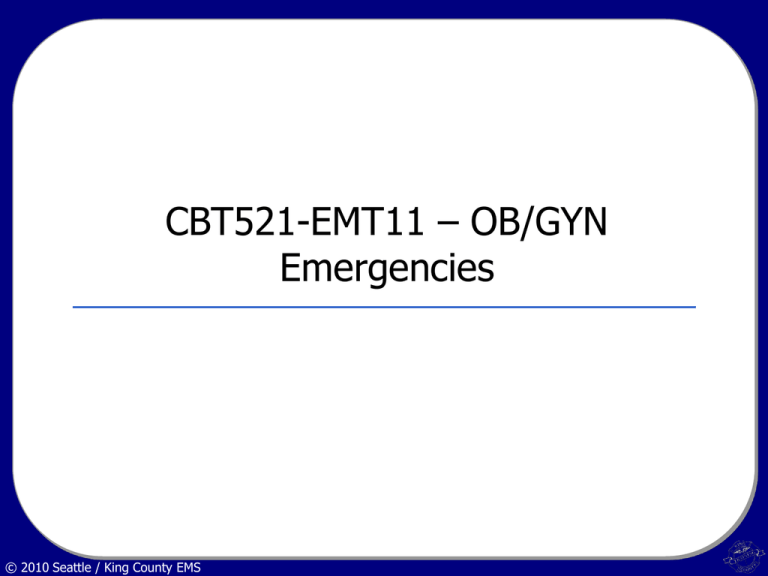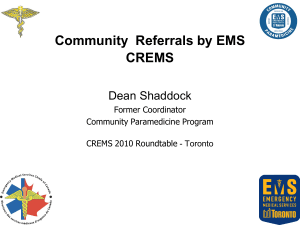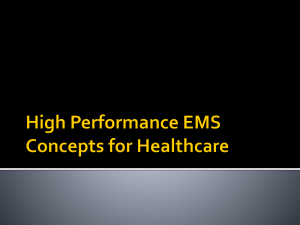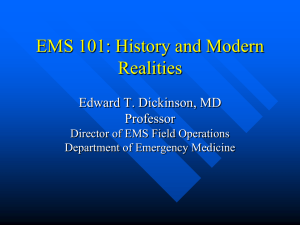
CBT521-EMT11 – OB/GYN
Emergencies
© 2010 Seattle / King County EMS
Introduction
• Many types of emergencies can occur with
female reproductive system
• This course will help you refresh your
assessment & treatment skills for emergency
childbirth & gynecological emergencies
© 2011 Seattle / King County EMS
Course Objectives
1.
2.
3.
4.
5.
6.
7.
8.
9.
10.
11.
Identify anatomic structures of the female reproductive system and their
functions.
Demonstrate a basic understanding of pregnancy-related physiology by
identifying appropriate statements on the menstrual cycle, ovulation, and
fetal development.
Identify signs/symptoms and proper care for gynecological emergencies.
Identify the key aspects of evaluating a pregnant patient to determine if birth
is imminent.
Identify the purpose and use of tools in an OB kit.
Identify the steps for normal delivery of an infant.
Identify how and when to cut an umbilical cord.
Identify the steps for post-delivery care of the newborn and mother including
delivery of the placenta.
Identify the critical treatment interventions for complications of pregnancy
including: breech (buttocks) or two limb presentation, shoulder dystocia,
prolapsed cord, and postpartum bleeding.
Identify steps for assessing an infant’s APGAR score.
Identify steps for neonatal resuscitation
© 2011 Seattle / King County EMS
Terms
abruptio placenta — This condition occurs when the placenta prematurely
separates from the uterine wall causing heavy internal bleeding and pain; it
can occur as a result of trauma.
bloody show — Mucous and blood that comes from the vagina as the first
stage of labor begins. The cervix is sealed by a plug of mucus during
pregnancy to prevent contamination. When the cervix dilates, the plug is
expelled as pink-tinged mucous.
crowning — The bulging out of the vaginal opening caused by the baby’s
head pressing against it.
dilation — To get larger or enlarge. The degree of dilation of the cervix is
often a key indicator used by midwives and physicians to determine if birth is
imminent. However, EMTs do not perform this test. The process occurs over a
period of several hours in some women, but can take much longer.
eclampsia (toxemia) — A serious condition that can develop in the third
trimester. It is characterized by high blood pressure and excessive swelling in
the extremities and face. Life-threatening seizures differentiate eclampsia from
preeclampsia.
© 2011 Seattle / King County EMS
Terms, continued
ectopic pregnancy — Condition where a fertilized egg implants
outside the uterus, often in the fallopian tubes. Symptoms can
include abdominal pain and vaginal bleeding.
effacement — A term relating to the thinning of the cervix.
meconium — A dark-green fecal material found in the intestines
of full-term babies. Ordinarily, the meconium is passed after a
baby is born. In some cases, the meconium is expelled into the
amniotic fluid prior to birth. It gives the fluid a greenish-brown
color known as meconium staining.
placenta previa — A condition where the placenta sits low in the
uterus blocking the cervix. It can present with painless, bright red
bleeding.
postpartum — A term used to describe the period shortly after
childbirth.
© 2011 Seattle / King County EMS
Terms, continued
preeclampsia — A condition found in pregnant women
characterized by high blood pressure, abnormal weight gain,
edema, headache, protein in the urine, and epigastric pain. If
untreated, preeclampsia can progress to eclampsia.
supine hypotensive syndrome — A pregnancy-related
condition where the weight of an unborn fetus and the uterus puts
pressure on the inferior vena cava. The result is inadequate
venous blood return to the heart, reduced cardiac output, and
lowered blood pressure.
© 2011 Seattle / King County EMS
New Terms
Braxton-Hicks — A Braxton Hicks contraction is defined by Taber's
Medical dictionary as an intermittent, painless contraction that may occur
every 10 to 20 minutes after the first trimester of pregnancy. These
contractions were first described in 1872 by British gynecologist John
Braxton Hicks. Sometimes these contractions are also called prelabor
contractions or Hicks sign. Not everyone will notice or experience these
contractions, and some will have them frequently. Some mothers say that
they notice them more in subsequent pregnancies than in their first
pregnancy.
© 2011 Seattle / King County EMS
Female Anatomy
Reproductive Organs
• Cervix – opening of the uterus
– First stage of birth, cervix opens
& thins
– Allows fetus to move into vagina
– Opening process called dilation
• Endometrium – inner lining of
uterus
– Each month built up in
anticipation of implantation of
fertilized egg
– Fertilization does not occur,
lining simply sloughs off
• Referred to as menstrual
period
© 2011 Seattle / King County EMS
• Fallopian tubes – long slender
passageways connect uterus to
ovary
– Female egg (ovum) passes
through structure on its way to
uterus for implantation to uterine
wall
• ovaries – two almond-sized
glands located on each side of
uterus behind & below fallopian
tubes
– Produce estrogen &
progesterone in response to
follicle stimulation hormone (FSH)
& luteinizing hormone (LH)
secreted from pituitary gland
Female Anatomy
Reproductive Organs
• Perineum – area between vaginal
opening & anus
–
It sometimes is torn during birth
which causes bleeding
• Uterus – pear-shaped, muscular
organ holds fetus during pregnancy
– Contracts to push fetus through
cervix & into vagina during birth
• Vagina – flexible, muscular tube
about three inches long
–
Called birth canal
– Fetus moves from uterus through
cervix into vagina & then out of
mother’s body
© 2011 Seattle / King County EMS
Fetal Anatomy
• Placenta – develops early in
pregnancy & performs important
functions
– Exchanges respiratory gases
– Transports nutrients from
mother to fetus
– Excretes waste
– Transfers heat
– Active endocrine gland produces
several important hormones
– Attached by umbilical cord
• Vein - transports oxygenated
blood toward fetus
• Artery – return deoxygenated
blood to placenta
• Amniotic sac – develops early in
pregnancy
– Consists of membranes surround
& protect developing fetus
– Fills with amniotic fluid cushions
fetus & provides stable
environment
• Umbilical cord – attaches fetus
to placenta
– Contains one vein & two arteries
– Vessels in umbilical cord similar
to pulmonary circulation
• Arteries carry deoxygenated
blood
• Veins carry oxygenated blood
– Newborn cord is about two feet
long
© 2011 Seattle / King County EMS
Fetal Anatomy
© 2011 Seattle / King County EMS
GYNECOLOGY
© 2011 Seattle / King County EMS
Menstrual Cycle
• Woman’s monthly hormonal cycle in which
uterus prepares to receive egg
• Then discharges a bloody fluid
• Cycle repeats on average every 28 days, but
can vary widely
© 2011 Seattle / King County EMS
Menstrual Cycle
•
Days 1 to 5
•
Egg has not been fertilized, hormone
levels become lower causing thickened
lining of uterus to shed
– Results in a woman’s period
– First day of menstrual bleeding is Day
1 in menstrual cycle
Hypothalamus & pituitary glands
release hormone causes mature follicle
to burst & release egg
– Ovulation typically occurs midway
through menstrual cycle on Day 14
– Egg begins its journey down fallopian
tubes to uterus
– Time period when a woman is most
likely to become pregnant
–
–
•
Days 6 to 14
Pituitary gland produces hormone
stimulates ovaries to develop follicles
each containing egg
– Only one egg reaches maturity & has
potential to become fertilized
– Hormone levels increase causing
lining of uterus to thicken & prepare to
receive mature egg
–
© 2011 Seattle / King County EMS
Days 10 to 18
•
Days 16 to 28
– After releasing egg, ruptured follicle
takes on a new role & secretes
progesterone which continues to
thicken lining of uterus in preparation
for fertilized egg
– If egg is fertilized by sperm, it
implants in lining of uterus
– If egg not fertilized or does not
implant, lining of uterus is shed again
at the beginning of the next menstrual
cycle
PID
• Pelvic inflammatory disease (PID) – infection
of female reproductive tract
–
–
–
–
–
Organs most commonly involved
Uterus
Fallopian tubes
Ovaries
Occasionally, peritoneum & intestines
© 2011 Seattle / King County EMS
PID
Symptoms of PID include:
–Lower abdominal pain
–Fever
–Abnormal vaginal
discharge
–Painful intercourse
–Irregular menstrual
bleeding
–Pain in right-upper
quadrant
© 2011 Seattle / King County EMS
• Vaginal bleeding & lower
abdominal pain can
indicate serious
gynecological problem
• Maintain high index of
suspicion when
encountered
PID
• Causes of PID
– Gonorrhea & chlamydia infections
• Can progress undetected before PID symptoms appear
– Other bacteria, such as staph or strep.
• Acute or chronic
– Allowed to progress untreated, sepsis can develop
• Most common symptom of PID – moderate
to severe, lower abdominal pain
© 2011 Seattle / King County EMS
Vaginal Bleeding
• Vaginal bleeding not result of direct trauma
or normal menstrual cycle can indicate a
serious problem
• Difficult to isolate a specific cause, treat all
vaginal bleeding as if there were serious
underlying condition
• Especially true if bleeding associated with
lower abdominal pain
© 2011 Seattle / King County EMS
Vaginal Bleeding
• Treatment depends on patient’s needs, but
may include the following:
–
–
–
–
Maintain ABCs
Control bleeding, if possible
Administer oxygen
Place in shock position
© 2011 Seattle / King County EMS
Dilation and Curettage (D&C)
• Dilation – opening of the
cervix
• Curettage – scraping the
walls of uterus
• Surgical procedure –
usually done on outpatient
basis under local
anesthesia
– Diagnose conditions such
as cancer
– Remove tissue after
miscarriage
– Elective abortion
© 2011 Seattle / King County EMS
• Complications
– Heavy bleeding –
uncommon
• Patients with heavy
bleeding
– Evaluate for signs of
shock
– Expedite transport to
hospital
Ovarian Cysts
• Egg is released from
ovary, cyst often left in its
place
• Cyst – fluid-filled sac
that is often enlarged
• Can rupture & cause
abdominal pain
• Occasionally cysts
develop independent of
ovulation
© 2011 Seattle / King County EMS
Ovarian Cyst
Sexual Assault
• Rape – any genital, oral or anal penetration
by a body part or object, through use of
force or without victim's consent
• It is a crime of violence with serious physical
and psychological implications
© 2011 Seattle / King County EMS
Sexual Assault
• Trauma to woman’s
external genitalia can be
difficult to treat
– Need to maintain
patient’s modesty
– Rich network of nerves in
external genitalia makes
such injuries painful
•Injuries to this area tend
to bleed profusely due to
rich blood supply
© 2011 Seattle / King County EMS
• Treat open wounds of
genitalia with moist,
sterile compresses
• Use direct pressure to
control bleeding
• Do not place dressings
in the vagina
OBSTETRICS
© 2011 Seattle / King County EMS
Ovulation
• Pregnancy begins with
ovulation in female
• Fourteen days before
beginning of next
menstrual period, ovary
releases egg into abdominal
cavity
• Egg enters fallopian tube
– transported to uterus
–Intercourse 24-48 hrs
before ovulation
– Fertilization can occur in
fallopian tube
© 2011 Seattle / King County EMS
Ovulation begins
Ovulation
• Once fertilized, egg
begins to divide
• Fertilized egg continues
down fallopian tube to
uterus
• Attaches to endometrium
© 2011 Seattle / King County EMS
Fetal Development
Some of the significant development changes:
Month
Development Milestone
1
Development of brain, spinal cord, & heart
2
Feet & hands are distinguishable
5
Fetal heart tones detected by stethoscope
6
Baby capable of surviving on own if born premature
8
Fetus has an excellent chance of survival
© 2011 Seattle / King County EMS
Trauma
• Direct abdominal trauma
can cause:
– Premature separation of
placenta from uterine wall
– Premature labor
– Abortion
– Uterine rupture
– Fetal death
© 2011 Seattle / King County EMS
• Fetal death can result
from:
– separation of placenta
from uterine wall
– maternal shock
– uterine rupture
– fetal head injury
Gestational Diabetes
• Some women develop diabetes during
pregnancy
• Pregnant diabetics are prescribed insulin if
blood sugar cannot be controlled by diet
alone
• Cannot be managed with oral drugs because
they absorbed into placenta & can adversely
affect fetus
© 2011 Seattle / King County EMS
Ectopic Pregnancy
• Implantation of growing
fetus in location other
than endometrium
• Most common site is in
one of the fallopian tubes
• Surgical emergency
because tube can rupture
& cause massive bleeding
1 month old embryo
6 week old embryo
© 2011 Seattle / King County EMS
Ectopic Pregnancy
• Patients with ectopic pregnancy often have
one-sided, lower abdominal pain, late or
missed menstrual period, & occasionally
vaginal bleeding
• Life-threatening emergency
• Treat for shock & initiate immediate
transport
© 2011 Seattle / King County EMS
Bleeding
• Vaginal bleeding during
pregnancy is cause for
concern
• Bleeding in early
pregnancy often
associated with
spontaneous abortion,
ectopic pregnancy, or
vaginal trauma
© 2011 Seattle / King County EMS
• Vaginal bleeding in third
trimester is usually caused
by:
– abruptio placenta
– placenta previa
– trauma to vagina or
cervix
• This can be a lifethreatening emergency
Bleeding
• Ranges from light spotting to massive
hemorrhage
• Difficult to determine cause of vaginal
bleeding in field
• Suspect placenta previa, abruptio placenta,
or vaginal trauma when you see vaginal
bleeding during third trimester
© 2011 Seattle / King County EMS
Abruptio Placenta
• Premature separation of
placenta from wall of uterus
• Separation can either be
partial or complete
–Complete separation usually
results in death of fetus
•Several factors may
predispose patient to abruptio
placenta
–
–
–
–
–
Preeclampsia
Maternal hypertension
Multiparity
Abdominal trauma
Short umbilical cord
© 2011 Seattle / King County EMS
Placenta Previa
• Attachment of placenta in
lower part of uterus covering
cervix
• Unless sonogram done,
placenta previa usually is not
detected until third trimester
• When fetal pressure on
placenta increases or uterine
contractions begin, cervix thins
out resulting in bleeding from
placenta
© 2011 Seattle / King County EMS
Hypertension
• Preeclampsia – condition characterized by
high blood pressure, abnormal weight gain,
edema, headache, & protein in urine
• Eclampsia – characterized by high blood
pressure & excessive swelling in extremities
& face
• Life-threatening seizures differentiate
eclampsia from preeclampsia
© 2011 Seattle / King County EMS
Preeclampsia
• Variety of signs and symptoms including:
–
–
–
–
–
–
Hypertension
Abnormal weight gain
Edema
Headache
Protein in the urine
Epigastric pain
• If untreated, preeclampsia can progress to
eclampsia
© 2011 Seattle / King County EMS
Eclampsia
• Eclampsia, also called
toxemia, most serious
manifestation of
hypertensive disorders of
pregnancy
• Characterized by grand
mal seizures
• Often preceded by visual
disturbances such as
flashing lights or spots
before the eyes
© 2011 Seattle / King County EMS
• Eclampsia patients often
experience swelling of
hands & feet & markedly
elevated blood pressure
• If eclampsia develops,
death of mother & fetus
frequently results
• Treat by lying mother on
her side, maintaining
airway, & delivering highflow oxygen
Supine Hypotensive Syndrome
• Supine hypotensive syndrome occurs when
increased weight of uterus compresses
inferior vena cava while a patient is supine
• Markedly decreases blood return to heart &
reduces cardiac output
• Some women are predisposed to this
condition because of an overall decrease in
circulating blood volume or anemia
© 2011 Seattle / King County EMS
Supine Hypotensive Syndrome
• Usually occurs in third
trimester of pregnancy
• Relieve it by tilting
mother to one side
Vena cava & aorta
compressed by fetus
© 2011 Seattle / King County EMS
Compression relieved by
tilting patient on left side
EMERGENCY
CHILDBIRTH
© 2011 Seattle / King County EMS
Signs of Imminent Delivery
• Main task in evaluating
expectant mother is to
determine if delivery is
imminent
• Expose abdomen &
genital area, taking care
to be discrete
• Visually inspect the
abdominal & vaginal areas
for bleeding or crowning
© 2011 Seattle / King County EMS
• Prepare for immediate
delivery if observe any of
the following:
– Crowning
– Contractions less than 2
minutes apart
– Rectal fullness
– Feeling of imminent
delivery
Crowning
• Crowning – appearance
of any part of fetus in
mother’s vagina
• Remove enough of
mother’s clothing to view
genital region
• Look for bulging at
vaginal opening or a
presenting part of infant
© 2011 Seattle / King County EMS
Crowning
Contraction Intervals
• Occur at regular intervals
ranging from 30 minutes to 2
minutes or less
• Labor pain from contractions
lasts from 30 seconds to 1
minute
• As birth approaches, interval
between contractions gets
shorter
• Contractions that occur within
2 minutes of each other, from
end of one to beginning of
next, signify impending delivery
© 2011 Seattle / King County EMS
• Consider transporting mother
if baby does not deliver after 20
minutes of contractions 2 to 3
minutes apart
• Labor is generally prolonged
for mother’s first baby
• Average is 12 to 17 hours
which allows plenty of time for
transport
Rectal Fullness
• Rectal fullness or sensation of having to
move one’s bowels can indicate infant’s head
is in vagina & pressing against the rectum
• Delivery is imminent
• Do not let the mother sit on the toilet
© 2011 Seattle / King County EMS
Feeling of Imminent Delivery
• Mothers who have previously given birth
often know when ready to deliver
• Labor tends to be shorter after first child
• Use your judgment given circumstances
• When evaluating mother, keep in mind four
signs of imminent delivery
• Consider transport time
© 2011 Seattle / King County EMS
Preparing for Delivery
• Request a paramedic
unit
• Don sterile gloves,
gown, and eye protection
• Position mother on her
back, legs drawn up
• Provide supplemental
oxygen
• Prepare OB kit
• Prepare infant BVM
© 2011 Seattle / King County EMS
Emergency delivery kit
Preparing for Delivery
Presentations You
Can’t Deliver
• Single limb
• Prolapsed cord
© 2011 Seattle / King County EMS
Presentations You
Can Deliver
• Head first (normal
cephalic)
• Umbilical cord around
the neck
• Shoulder dystocia
• Buttocks first
• Double footling
Assisting With Delivery
•
•
•
•
•
•
•
Support head with gentle pressure
Check if cord is wrapped around baby’s neck— attempt to loosen
Apply gentle downward pressure on shoulder & head
After anterior shoulder has delivered, apply gentle upward
pressure
Suction mouth (no more than 1 inch into) & nostrils (no more than ½
inch into each) when head appears
Once delivered, stimulate infant if it does not breathe
Put two clamps on umbilical cord & cut 6 inches from navel
Suction mouth & nostrils
© 2011 Seattle / King County EMS
Delivery anterior shoulder
Delivery posterior shoulder
Amniotic Sac
• During first stage of
labor amniotic sac usually
breaks, expelling amniotic
fluid
• If sac is still covering
infant’s head when head
appears, use a finger to
pierce sac
• Find it very tough
© 2011 Seattle / King County EMS
• Note color & character
of amniotic fluid
• Fluid can be clear or
straw-colored (which is
normal)
• Tainted & discolored, or
thick & “pea soup-like”
(which indicates
meconium staining)
Detailed Delivery Instructions
1. Encourage the mother to breath deeply between contractions
and push with contractions.
2. As the baby crowns, support with gentle pressure over
perineum to avoid an explosive birth.
3. If the amniotic sac is still intact, rupture it with a finger to allow
amniotic fluid to leak out.
4. As soon as the baby’s head appears, suction mouth & nostrils
with a bulb syringe – squeeze air from syringe before inserting,
insert syringe no more than 1 inch into mouth, no more than ½
inch into each nostril.
5. If the umbilical cord is wrapped around the baby’s neck, gently
slip it over the head. Do not force it! If the cord is too tight to
slip over the head, apply umbilical cord clamps and cut the
cord. Clamp and cut the umbilical cord only if he baby’s head
has emerged and is in a position that lows you to manage the
airway.
© 2011 Seattle / King County EMS
Detailed Delivery Instructions
6. Encourage the mother to push. Support the baby’s head as it
delivers. Caution, babies are slippery!
7. To assist in delivery of the anterior shoulder, apply gentle
downward pressure on the shoulder and head.
8. As soon as the anterior shoulder has delivered, apply gentle
upward pressure to assist in the delivery of the posterior
shoulder.
9. Once both shoulders have delivered, be ready for the remainder
of the body to deliver quickly. Newborn babies are slippery so
handle carefully.
10. Stimulate the newborn to breathe by tapping the feet, if
necessary.
11. Once pulsations have stopped, clamp the cord by placing a
clamp approximately 6 inches from the baby. Place a second
clamp approximately 2 inches from the first, then cut the cord
between the clamps.
© 2011 Seattle / King County EMS
Detailed Delivery Instructions
12. Re-suction the baby’s mouth & nostrils only if baby
not breathing or having respiratory distress
13. Dry & wrap baby in a warm blanket — cover its
head
14. Place baby on its side to facilitate drainage
15. Perform an APGAR assessment at 1 minute & 5
minutes after delivery
© 2011 Seattle / King County EMS
Care of the Infant
• Baby not breathing – stimulate it by rubbing its back
or tapping your fingers on soles of its feet
• If newborn does not start breathing effectively within
10 – 15 seconds of stimulation, use infant BVM to
deliver gentle puffs of air — enough to cause the
chest to rise
• If after 30 seconds of assisted ventilation there is no
response & heart rate is less than 60 beats/min,
begin CPR
© 2011 Seattle / King County EMS
Care of the Infant
• Keep newborn warm by drying it & then
wrapping it in warmed blankets
• After cord is clamped & cut, cover head
• Be careful because a wet baby is very
slippery
• Repeat suctioning of nose & mouth, if
needed
• Remember to check APGAR score at 1 & 5
minutes
© 2011 Seattle / King County EMS
Meconium Staining
• If see signs of meconium staining, do not
stimulate infant before suctioning mouth &
nose
• This avoids aspiration of fecal material that
can cause pneumonia
© 2011 Seattle / King County EMS
APGAR
• APGAR scale – numerical
measure of baby’s overall
condition immediately
after birth
• Perfectly healthy baby
will have total score of 10
• Many babies score 7 to
8 during first minute
• By 5 minutes, most
babies score 8 to 10 on
scale
© 2011 Seattle / King County EMS
APGAR stands for:
• Appearance
• Pulse
• Grimace
• Activity
• Respirations
APGAR Scale
Scale
Sign
Score
1
2
Blue, pale
Body pink,
extremities blue
Completely pink
Pulse
Absent
<100
>100
Grimace
No response
Grimaces
Cries
Limp
Some flexion of
extermities
Active motion
Absent
Slow & irregular
Strong crying
Appearance
0
(color of skin, nailbeds, or lips)
(reflex, irritability)
Activity
(muscle tone)
Respirations
Total
© 2011 Seattle / King County EMS
1 min
5 min
Managing a Poor APGAR Score (PSS)
• Three things to remember when managing
infant with low APGAR score: position,
suction and stimulate (PSS)
– Position body so head is down & airway is open
– Suction mucous & fluid from mouth & nostrils
– Stimulate infant by taping bottoms of feet
• PSS – memory aid to help recall these steps
— position, suction and stimulate
© 2011 Seattle / King County EMS
Care of the Mother
• Once baby delivered &
umbilical cord cut &
clamped you should:
– Monitor and control
bleeding from mother
– Begin fundal massage
– Monitor vital signs
– Keep the mother and
baby warm
© 2011 Seattle / King County EMS
• Transport once infant is
delivered
• Do not wait for
placenta—may take up to
30 minutes to deliver
• Do not pull on umbilical
cord
• If placenta does deliver
at scene, transport with
mother & baby to hospital
Monitor and Control Bleeding
• After placenta delivered, place sanitary
napkin between mother’s legs
• Ask her to hold legs together
• Normal for mother to bleed up to one cup
(about 250 cc) or 5 sanitary napkins of blood
after delivery
• Record number of pads
© 2011 Seattle / King County EMS
Fundal Massage
• Makes uterus contract &
diminishes vaginal bleeding
• Can feel for fundus of uterus,
located in abdomen between
pubic bone & umbilicus
Video demonstration available at EMS
• Should feel like a softball
Online:
• Perform massage like you
http://www.emsonline.net/obgyn2011/
mother.asp
would a firm muscle massage
• Area may be tender &
massaging it can cause
discomfort
© 2011 Seattle / King County EMS
COMPLICATIONS
FIELD CARE
© 2011 Seattle / King County EMS
Umbilical Cord Around Neck
• Once head delivered ask mother to stop pushing so you can
check if cord is wrapped around infant’s neck
• If cord looks like it is wrapped tightly, so as to constrict airway,
need to loosen it
• Gently slip cord over baby’s head by placing two fingers under
cord at back of neck
• Bring cord over shoulders & head
• Cord durable, it can tear if handled roughly so don’t use
excessive force
• Too tight to loosen, clamp cord in two places two inches apart
• Cut cord between clamps
• Unwrap cord from around neck & take care not to injure baby
Video demonstration available at EMS Online:
http://www.emsonline.net/obgyn2011/neck.asp
© 2011 Seattle / King County EMS
Shoulder Dystocia
• Labor progresses normally & head delivered routinely
• However, immediately after head deliveres,
shoulders become trapped between symphysis pubis
& sacrum, preventing further delivery
• First step in treating shoulder dystocia is recognizing
when it occurs
• Two main signs of shoulder dystocia are:
– Baby’s body does not emerge with standard moderate
traction & maternal pushing after delivery of baby’s head
– “Turtle Sign” –head suddenly retracts back against mother’s
perineum after it emerges from vagina
© 2011 Seattle / King County EMS
Shoulder Dystocia
Do’s & Don’ts of McRoberts
Maneuver
Do
• Pull knees backwards
(towards patient’s ears) & out
to side to rotate & open the
Video demonstration available at EMS
pelvis
Online:
http://www.emsonline.net/obgyn2011/
• Use suprapubic pressure to
dystocia.asp
untrap the shoulder from
behind pelvis
Do Not
• Do not pull forcefully on
baby’s head
• Absolutely, no fundal pressure
© 2011 Seattle / King County EMS
Buttocks & Double Footling Presentation
• If buttocks or two feet
present first, you can attempt
delivery in field
• These are generally slow
deliveries & you likely have
time to transport
© 2011 Seattle / King County EMS
Key points are:
• Request paramedic unit
• Position mother with buttocks
at edge of bed
• Hold mother’s legs in flexed
position
• Support infant’s legs — do
not pull
• As head passes pubis, apply
gentle upward traction until
mouth appears
• If head is stuck, create airway
by pushing away vaginal wall —
transport immediately
If Head Does Not Deliver
• Create airway for infant
• First, place gloved hand into vagina with your
palm towards infant’s face
• Form a “V” with index & middle finger on
either side of infant’s nose
• Push vaginal wall away from infant’s face to
allow unrestricted breathing
• Maintain airway & transport immediately
© 2011 Seattle / King County EMS
Postpartum Bleeding
• Important steps in
caring for postpartum
bleeding include:
– Fundal massage
– Treat for shock
– Do not force delivery of
placenta
– Place sanitary napkin at
opening of vagina
Fundal massage
© 2011 Seattle / King County EMS
Neonatal Resuscitation
• After delivery, if infant not breathing effectively after
10 to 15 seconds of stimulation, begin assisted
respirations
• Use infant BVM with high-flow oxygen at a rate of 40
to 60 breaths/min
• If pulse rate falls below 60 beats/min, start
compressions & ventilations at ratio of 3:1 at 120
events/min (which is 90 compressions & 30
ventilations)
• Remember, ventilation is the most important action
in neonatal resuscitation
© 2011 Seattle / King County EMS
CPR - Two-Thumb Encircling Hands Technique
CPR technique for infant with pulse
rate below 60 beats/min
1. Place infant on a firm, flat
surface
2. Remove clothing from chest
3. Find compression site which is
just below nipple line on middle
or lower third of sternum
4. Wrap your hands around upper
abdomen with your thumbs on
compression site
5. Use your thumbs to deliver
gentle pressure against
sternum, pressing ½ to ¾ inch
into chest
© 2011 Seattle / King County EMS
MUST TRANSPORT
© 2011 Seattle / King County EMS
Single Limb Presentation
Key points of assisting with single limb
presentation include:
• Support baby with your hands
• Provide airway for baby using your fingers
• Transport immediately — do not attempt
delivery in field
© 2011 Seattle / King County EMS
Prolapsed Cord
If you see umbilical cord in vagina,
presenting before the baby,
initiate the following steps:
1. Request a paramedic unit
2. Place mother in knee-chest
position
3. Check umbilical cord for pulsations
4. No pulsations - press presenting
part of fetus away from
umbilical cord, towards mother’s
head
5. Re-check cord for pulsations
Prolapsed cord
© 2011 Seattle / King County EMS
6. Administer high flow oxygen to
mother
7. Transport immediately – fetus will
die quickly without rapid
intervention
8. Continue holding presenting part
of baby away from umbilical
cord
9. Apply moistened dressing on
exposed umbilical cord
10. Do not push umbilical cord back
into vagina
Knee-chest position
Case Study
Video Case Study
http://www.emsonline.net/obgyn2011/case1.asp
© 2011 Seattle / King County EMS
Summary
Key structures of female
reproductive system
include:
–
–
–
–
–
–
–
Cervix
Endometrium
Fallopian tubes
Ovaries
Perineum
Uterus
Vagina
© 2011 Seattle / King County EMS
The key structures of fetal
anatomy include:
– Placenta
– Amniotic sac
– Umbilical cord
Summary
Care for vaginal bleeding
includes:
– Maintain ABCs
– Control bleeding, if
possible
– Administer oxygen
– Place in shock position
© 2011 Seattle / King County EMS
Signs of imminent delivery
include:
– Crowning
– Contractions less than 2
minutes apart
– Rectal fullness
– Feeling of imminent
delivery
Summary
• Fetus has excellent chance of survival after the
seventh month of pregnancy
• Pregnant women more susceptible to traumatic
injury because of th increased vascularity of uterus
• Patients with ectopic pregnancy often have onesided abdominal pain, late or missed period, &
occasionally vaginal bleeding
• Vaginal bleeding in third trimester usually caused by
abruptio placenta, placenta previa, or trauma
• To relieve supine hypotensive syndrome tilt the
pregnant patient to one side
© 2011 Seattle / King County EMS
Summary
Key points for assisting with normal delivery:
• Support head with gentle pressure
• Check if cord wrapped around baby’s neck—if so, attempt to loosen
• Apply gentle downward pressure on anterior shoulder and head
• After anterior shoulder has delivered, apply gentle upward pressure
on posterior shoulder & head
• Suction mouth and nostrils when head appears
• Once delivered, stimulate newborn if it does not breathe
• Put two clamps on umbilical cord & cut 6 inches from navel
Care for newborn infant includes:
• Stimulate infant if not breathing sufficiently
• Start CPR if no response after 30 seconds
• Keep infant warm
• Repeat suctioning of mouth & nose
• Check APGAR score at 1 & 5 minutes
© 2011 Seattle / King County EMS
Summary
• APGAR stands for appearance, pulse, grimace,
activity, & respirations
• Care of mother includes:
–
–
–
–
Monitor & control bleeding from mother
Begin fundal massage
Monitor vital signs
Keep mother & baby warm
• If head remains stuck during buttocks or double
footling presentation, create airway by pushing away
vaginal wall then transport immediately
• Important steps in caring for postpartum bleeding
include fundal massage and treatment of shock
© 2011 Seattle / King County EMS
Questions
EMS Online
Guidelines and Standing Orders
http://www.emsonline.net/downloads.asp
Susan Kolwitz
Program Manager
Email support: help@emsonline.net
Dr. Mickey Eisenberg
Medical Director
Ask the Doc: http://www.emsonline.net/doc.asp
© 2011 Seattle / King County EMS








